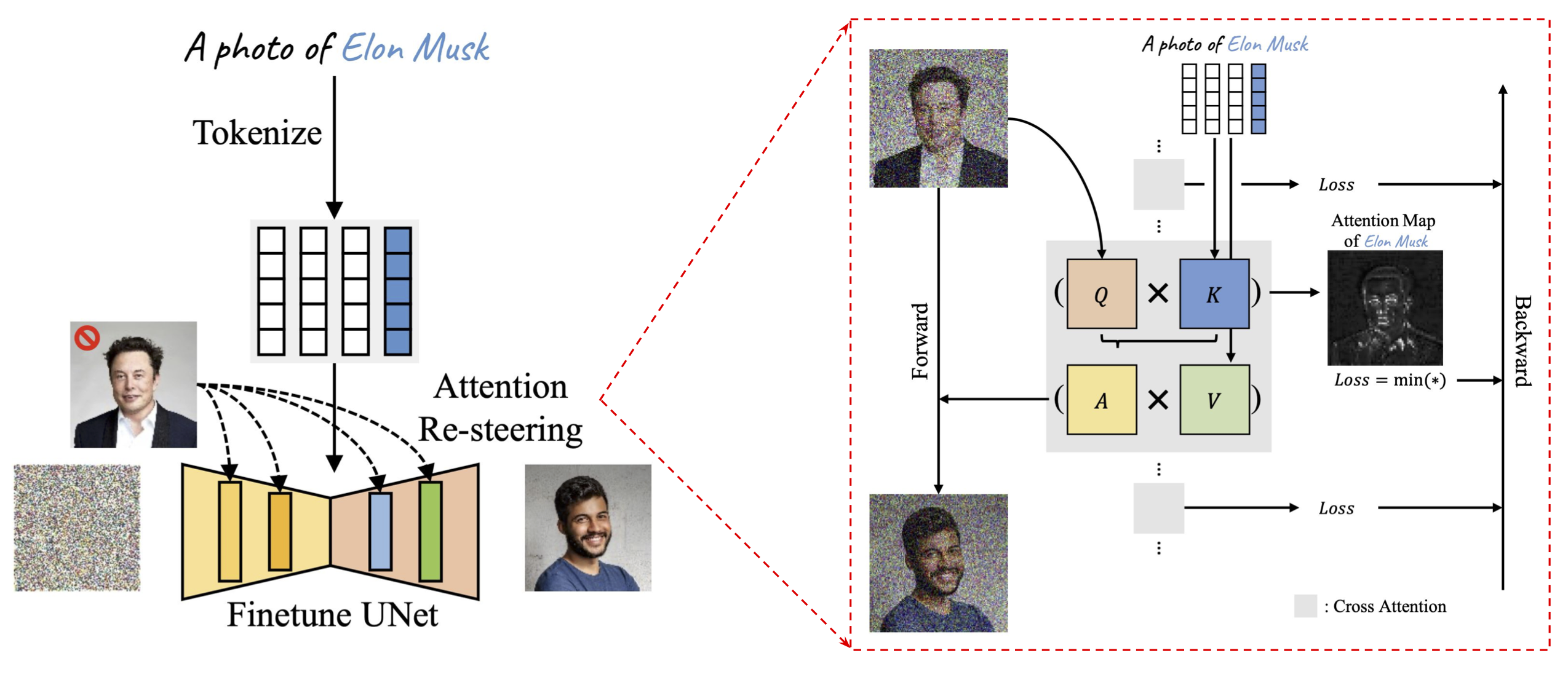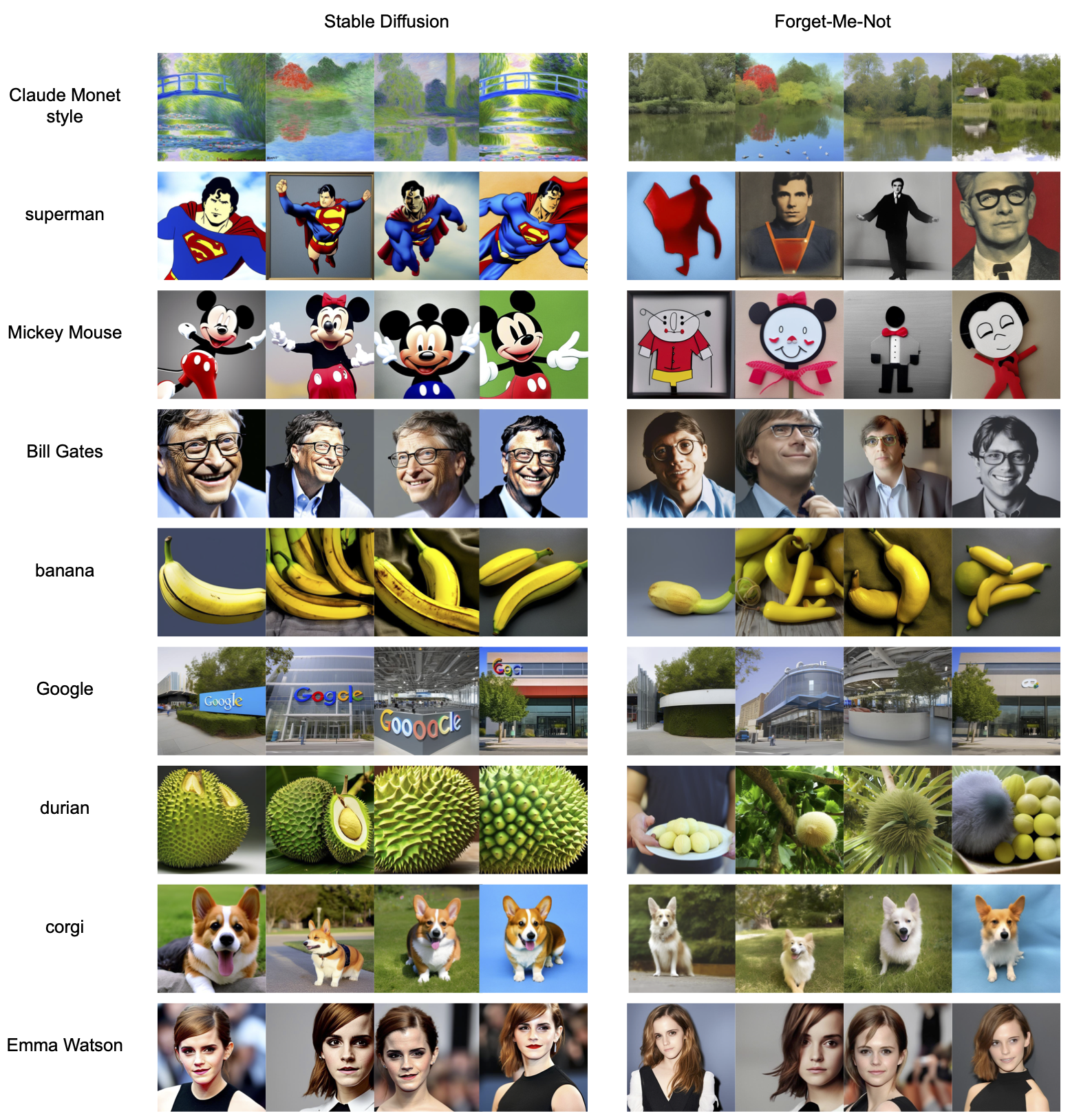Eric Zhang†, Kai Wang†, Xingqian Xu, Zhangyang Wang, Humphrey Shi
† Equal Contribution
This repo contains the code for our paper Forget-Me-Not: Learning to Forget in Text-to-Image Diffusion Models.
The significant advances in text-to-image generatve models have prompted global discussions on privacy, copyright, and safety, as numerous unauthorized personal IDs, content, artistic creations, and potentially harmful materials have been learned by these models and later utilized to generate and distribute uncontrolled content.
To address this challenge, we propose Forget-Me-Not, an efficient and low-cost solution designed to safely remove specified IDs, objects, or styles from a well-configured text-to-image model in as little as 30 seconds, without impairing its ability to generate other content. Alongside our method, we introduce the Memorization Score (M-Score) and ConceptBench to measure the models’ capacity to generate general concepts, grouped into three primary categories: ID, object, and style. Using M-Score and ConceptBench, we demonstrate that Forget-Me-Not can effectively eliminate targeted concepts while maintaining the model’s performance on other concepts. Furthermore, Forget-Me-Not offers two practical extensions: a) removal of potentially harmful or NSFW content, and b) enhancement of model accuracy, inclusion and diversity through concept correction and disentanglement. It can also be adapted as a lightweight model patch for Stable Diffusion, allowing for concept manipulation and convenient distribution.
We hope our research and open-source here encourage future research in this critical area and promote the development of safe and inclusive generative models.
- Forget-Me-Not is a plug-and-play, efficient and effective concept forgetting and correction method for large-scale text-to-image models.
- It provides an efficient way to forget specific concepts with as few as 35 optimization steps, which typically takes about 30 seconds.
- It can be easily adapted as lightweight patches for Stable Diffusion, allowing for multi-concept manipulation and convenient distribution.
- Novel attention re-steering loss demonstrates that pretrained models can be further finetuned solely with self-supervised signals, i.e. attention scores.
- [July 17, 2023]: Code is available!
conda create -n forget-me-not python=3.8
conda activate forget-me-not
pip install torch==1.13.1+cu116 torchvision==0.14.1+cu116 torchaudio==0.13.1 --extra-index-url https://download.pytorch.org/whl/cu116
pip install -r requirements.txt
- First, train Ti of a concept. Optional, only needed if
use_ti: trueinattn.yaml.
python run.py configs/ti.yaml
- Second, use attention resteering to forget a concept.
python run.py configs/attn.yaml
- Results can be found in
exps_tiandexps_attn.
- Modify
ti.yamlto tune Ti. In practical, prompt templates, intializer tokens, the number of tokens all have influences on inverted tokens, thus affecting forgetting results. - Modify
attn.yamlto tune forgetting procedure. Concept and its type are specified undermulti_conceptas[elon-musk, object]. During training,-will be replaced with space as the plain text of the concept. A folder containing training images are assumed atdatafolder with the same nameelon-musk. Setuse_tito use inverted tokens or plain text of a concept. Setonly_optimize_cato only tune cross attention layers. otherwise UNet will be tuned. Setuse_poolerto include pooler token<|endoftext|>into attention resteering loss. - To achieve the best results, tune hyperparameters such as
max_train_stepsandlearning_rate. They can vary concept by concept. - Use precise attention scores could be helpful, e.g. instead of using all pixels, segment out the pixels of a face, only using their attention scores for forgetting an identity.
If you found Forget-Me-Not useful in your research, please consider starring ⭐ us on GitHub and citing 📚 us in your research!
@article{zhang2023forgetmenot,
title={Forget-Me-Not: Learning to Forget in Text-to-Image Diffusion Models},
author={Eric Zhang and Kai Wang and Xingqian Xu and Zhangyang Wang and Humphrey Shi},
journal={arXiv preprint arXiv:2211.08332},
year={2023}
}We thank the authors of Diffusers and LoRA for releasing their helpful codebases.


